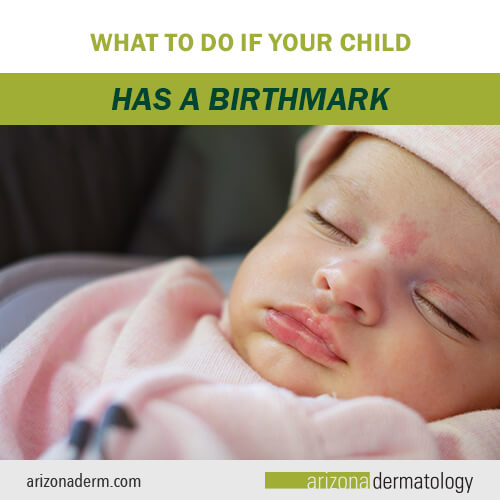 Discovering your child has a birthmark can be concerning. A quick visit to the dermatologist can give you answers and help you understand whether a birthmark is something to worry about or not.
Discovering your child has a birthmark can be concerning. A quick visit to the dermatologist can give you answers and help you understand whether a birthmark is something to worry about or not.
A birthmark is a patch of skin on your baby visible at birth or shortly after birth that is different from the rest of their skin. Birthmarks may be flat or raised. They can be tiny or cover a large area. Birthmark colors vary over a wide range, from pink, red, tan or brown, to what may look like a bruise or stain. Some birthmarks fade over time. Others remain for life.
Some birthmarks are an indication that something else is going on in your baby’s body. This is why it is important to have a dermatologist assess the birthmark.
Types of Birthmarks
Here are some of the more common birthmarks.
Strawberry Hemangioma (superficial infantile hemangioma). The strawberry hemangioma usually looks like a firm, rubbery, strawberry-like lump on your child’s skin. Sometimes, instead of a lump, you may see a strawberry-colored patch or patches. Strawberry hemangiomas often develop on the head or neck, but can appear anywhere, including in the mouth or on the anus. These birthmarks often grow for the first four to six months of life. After that, they stop growing and begin to shrink, usually disappearing on their own. About 10% of strawberry hemangiomas disappear by age one. About 90% are gone by age 10.
Special considerations: As a strawberry hemangioma shrinks, it may become painful as the skin breaks down. If this happens, we can help with wound care to speed healing and relieve the pain.
Deep hemangioma (cavernous infantile hemangioma). A deep hemangioma looks like a lump deep in the skin. It can be skin-colored or bluish-purple, and its blood vessels may be visible as thin red lines. This birthmark often feels warm and firm to the touch. Deep hemangiomas grow quickly for up to a year after birth. Most fade on their own after that, but it can take several years. About half of deep hemangiomas are gone by age five. About 90% will be gone by age 10. As it fades, this birthmark may leave behind a light spot or scar.
Special considerations: Bring your child in if a deep hemangioma is painful or if it breaks open and bleeds.
Salmon Patch (nevus simplex). Also called a “stork bite” or “angel’s kiss,” this flat pink, red, or salmon-colored patch often appears on the face or the back of the neck. It tends to grow darker when the baby cries or becomes overheated. Salmon patches are common, aren’t dangerous, and usually disappear between one and three years of age. Some salmon patches that don’t occur on the face may never truly fade.
Cafe-au-lait Spot (cafe-au-lait macule). This flat spot that is darker than your child’s skin may look like coffee with milk on fair skin or black coffee on dark skin. It can be the size of a freckle or far larger. Cafe-au-lait spots can appear anywhere, but often develop on the buttocks. These birthmarks do not fade on their own. They are there for life.
Special considerations. If the cafe-au-lait mark is located in a visible place, we may be able to treat it with lasers. If your child has six or more cafe-au-lait spots, or if freckles develop around the cafe-au-lait spot, come see us right away. It could be a sign of a more serious disorder called neurofibromatosis type 1.
Mole (congenital melanocytic nevus). A mole that is visible at birth or that appears shortly after birth is considered a birthmark. Moles as birthmarks can look like any other mole, and can appear anywhere on the skin and be any size. Some are smooth, others rough. Most are brown or tan. Some moles disappear, but most remain on the skin for life.
Special considerations. Because of the danger of melanoma developing in a mole, this type of birthmark should be seen by a dermatologist.
Mongolian Spot (dermal melanocytosis). This harmless birthmark is blue or gray and often looks like a bruise on the lower back or buttocks. Babies may have one or several. They can vary greatly in size. While babies of any race can have Mongolian spots, they are least common in white children and most common in Asian children. Most Mongolian spots go away on their own by the time a child is three to five years old. That said, some adults still retain this birthmark.
Port-wine Stain (nevus flammeus). Port-wine stains look like pink, red, or purple spots or patches of skin, often on the face. This birthmark grows and tends to thicken and darken as it does. Ridges can develop. Sometimes it has a cobbly texture. Without treatment, port-wine stains will remain for life. Laser therapy is currently the best treatment for port-wine stains, shrinking the blood vessels and making the birthmark less visible.
Special considerations. Some port-wine stains can be very dry. If this is the case with your child, moisturize the skin once or twice a day using a dye-free, fragrance-free moisturizer.
White Spot (hypopigmented macule). White spots aren’t always white, but they are a patch of skin that is less pigmented than the surrounding skin. The spot can be raised or flat, round, oval, leaf-shaped, or another shape. Most are found on the chest, back, abdomen or buttocks. White spots usually disappear on their own.
Pediatric Dermatology at Arizona Dermatology
If you have any concerns about your child’s skin, bring them in to see one of our board-certified dermatologists. We provide dermatological care to patients of all ages and can give you peace of mind or discuss treatment options for skin conditions affecting your child’s physical or emotional well-being.


